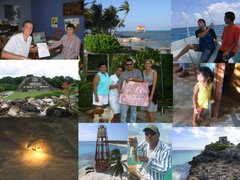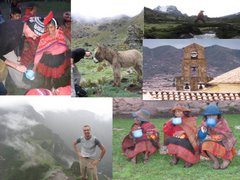
Hey all. Just a shout out for a new aussie movie opening at the start of June. Got Guy Ritchie... Won the Sundance Best Picture... Looks goooooood.
Here's the trailer.

How rich are you? >> I'm loaded. It's official. I'm the 49,847,130 richest person on earth! |
 Rowan and Colette. I love this pic!
Rowan and Colette. I love this pic!Hello! I expect a few regular readers have given up on me in the two and a half months since I last updated this blog. Apologies. I hadn’t forgotten. I have wanted to write something, but there just always seemed to be something else to do…
Hopefully a brief account of what I’ve been up to since November will act as some penance. :)
My usual themes are: working in the development field, life in
When I last updated the blog at the start of November, I’d just returned from an inspiring trip to
Since then, I’ve been working to formalise processes for supporting both this project, and any future non-microfinance projects that we might wish to fund. Otherwise, the last three months at work have been typical of any three-month period since I joined
Philippines for 2 years, while, Chris, the head of our Strategic Services Department (and my boss) has moved with his family to India for a year.
Right: At Ed's wedding.
This has changed my typical working day. Not least because, with my boss moving to
I didn’t take any leave over Christmas. I even worked in the office on my own for two days. I already feel like I’ve hit the ground running in 2010 and I’m enjoying the job a lot again. Plus, I’ll be going to
Christmas Work Do
The last time I wrote about anything other than work on this blog… hmmmm, I shouldn’t even say (blush). The subject was the ‘Spring on the Rooftop’ party. Seems like about, I dunno… four seasons ago now. I’ve hosted another rooftop party since then.  Great party. Same people, different season, and a different rooftop. At the start of October I saw an apartment for lease that I liked. I’d been looking casually for 6 months. It’s nice to look when you don’t have any need to take the plunge as you can afford to be very fussy (I’m sure there’s an analogy with dating there, but I’m not going to say it).
Great party. Same people, different season, and a different rooftop. At the start of October I saw an apartment for lease that I liked. I’d been looking casually for 6 months. It’s nice to look when you don’t have any need to take the plunge as you can afford to be very fussy (I’m sure there’s an analogy with dating there, but I’m not going to say it).
I love the new place. A one bedroom apartment feels like a big improvement from a studio, and the building itself is impressive. Harry Seidler was
My apartment block is one of his earlier, more modest efforts, built in the 1960s, but it’s still an interesting design, with the rooftop overlooking the Bridge and Opera House the highlight. I’ve moved closer to the harbour, closer to a nicer, quieter part of town, and there’s an icing on the cake. Where my last place had a gym that I never used, this place has a rooftop pool that I’m cooling off in at least three times a week. And it’s been a blessing in the last few months. Yes… get ready to start throwing bricks, I’m going to talk about this summer’s weather.
In the interests of keeping it brief, I’ll just mention today’s weather. It’s a Saturday, so I can’t tell you what the weather was like before 10am. Damn hot I’ll bet. By 11am when I got to Bronte beach it was 37C. The peak was 41C at 230pm, but that all changed when the temperature dropped 15 degrees in an hour as a storm barrelled across the city. As I write this it’s almost impossible to tell what will happen in the next few hours. There’s a free open-air concert in the Domain tonight but I’ll be taking the safe option of watching the Australian open on TV instead.
There seems to be a weather record broken in
Ok, enough amateur meteorology.
I couldn’t mention the last two months without breaking a bit of a personal taboo. Since I started this blog, I haven’t mentioned romance, aside from a few unheralded references. But there can’t be anyone I haven’t already told about Alise Grinfelde, so it will come as news to no-one that I’ve spent a considerable amount of time in the last few months corresponding with a girl that I met at Ed and Dace’s wedding in October. Alise is a fellow European, but unlike me is still braving the frosty European winters. In
Aija and Alise
So, I hope that all goes some way to explaining the lengthy silence in the blogosphere. If I’d written as many words on this blog as I’ve sent to
Famous last words, but more updates will follow soon! I’ve written an article on my friend Dom’s art Mardi Gras exhibition that I just have to talk about.There’s the trip to

I’ve seen a lot of the Indian subcontinent now, the North (
Orissa stretches along hundreds of miles of
Despite vast mineral reserves, that are only now being tapped by international mining companies, Orissa is marked by having possibly the worst development stats of any Indian state. Life expectancy is shorter, education levels lower, infant mortality rates higher than anywhere else in a country which generally performs very poorly on the Millenium Development Goals. And that’s why Opportunity International have more partners based in Orissa, than in any other state.
If you want to tackle poverty, this is the place to come.
I was the first person from
Of the three microfinance institutions that we work with in Orissa, Manas and I visited Peoples Forum – one of our newest partners – to review their work generally, and to make a visit to a very interesting new development project there.
We met two groups of women who are part of a microfinance program that has been running since 1989 and now has 25 branches and 35,000 clients.
The first group of 10 women make saris. They have borrowed Rp10,000 (about $250) each from Peoples Forum to pay for materials. They will repay the money over 18 months and then be eligible to borrow more money and expand their business. It was important to see where the women work – each of the rooms is barely bigger than the loom it accommodates. The rooms are dark with small windows, which are lit by light bulbs even in the middle of the day. And the work is hard, physical work. There’s a lot of effort needed to operate the machines.
And what do they get for this hard work?
Before Peoples Forum came along and provided the group with a loan, each of the women saved around Rs50 per month, and over a period of 18 months they had saved Rs1050 each in total, or about $25 in total.
Imagine where you were 18 months ago and then imagine you had spent every day since then working 8 hours a day in a small, dark room in a tropical environment, just to earn as much money as the typical Australian would spend on a round of drinks or a couple of cinema tickets. It’s staggering.
But the MFI is trying to change this. By giving the women training and business support, they can earn more for the saris and increase their income and the amount they can save.
The second group was even more interesting. The women here make ropes from raw material, again working 7-8 hours a day in the tropical heat, where peak temperatures can be 47C.
They purchase about $30 of raw material and it takes the group of 10 women 3 days to turn that into ropes which they sell for about twice as much. All told, this gives them an income of about $1 each per day. But again the MFI is giving the women hope of improving their lives. Through a loan, they will purchase an additional machine that will allow them to work more effectively, and they are even building a ‘factory’ of sorts that will let them work indoors in the monsoon season.
What is really remarkable about this group is that the majority of them used to be lepers (they are ex-lepers as Monty Python would say). The houses that they are building with the profits from their rope making business are being built virtually next to a government-built leprosy mission. And they used to live in the mission, until they were cured.
It is remarkable to think of the obstacles these women have had to overcome. Not just issues of caste, poverty and their status as women in
This is something that microfinance has always been about –demonstrating that people who are poor and excluded still have value in society. The work that Peoples Forum are doing is just taking that one step further.
And the last program we visited on the day is arguably yet more ambitious.
Mission Ashra is Peoples Forum’s project to provide care and shelter and rehabilitation to women who have ended up abandoned on the streets because they are mentally ill.
Why do they end up on the streets? Firstly, there is a real stigma attached to mental illness in
The natural reaction to this is horror and disgust. But understanding why this can happen is important to understanding why the small ashram that Peoples Forum is running could have a transformational impact far beyond its doors.
Attitudes to mental illness are shaped by education and experience. A lack of education and community awareness in the poorest parts of rural India, mean that mental illness is often thought to be incurable, a curse, and something that dehumanises people. This leads to a situation where the family feels that abandoning the individual is the only option they have.
The second reason that so many mentally ill women languish on the streets is that, once they are in that situation where they’ve been abandoned, they have very limited capacity to help themselves. If you’re suffering from depression or schizophrenia, you find it difficult to seek help or to even look after yourself. And these women are very vulnerable. When the ashram rescues women, many of them have been the victims of physical or sexual abuse.
Almost all of the 150 women at the Ashram are from a very poor background. Many have been rescued as a result of a call to a public helpline that the Ashram provides. When they arrive at the ashram the woman will find herself in a site about as big as football field, maybe a little longer, and a little narrower. The facilities are limited. There isn’t even enough space in the rooms for beds. The beds have now been taken out and mattresses placed on the floor to accommodate the women.
There are a formidable list of mental conditions here (depression on its own would rarely be enough to see someone end up at the Ashram) and I feel sure even the best resourced facilities would find this patient-load challenging.
But, despite limited space and resources, the Ashram does appear to have great success in looking after patients. Drugs are part of the answer – they have a full time pharmacist – and psychiatric care is available from nurses and a part-time psychiatrist. At the same time its obvious that drugs and medical attention are only part of the rehabilitation process. Perhaps just as important is the love and care being provided. On top of that, the Ashram makes stimulating activities a key part of the women’s daily experience. Yoga, music, gardening… these all provide some routine and stability to the patients’ lives, something to fill their time, and to give them some meaning.
But of course the ultimate goal is to treat the illness and make the women well again and able to go back to their families. That’s absolutely the aim of the ashram. And reuniting women with their families is a key part of what they do.
And they have mixed success, which is perhaps not surprising. You can split the women into a couple of different groups. There are a group of women who have ‘gone missing’ – perhaps run away from home, or been abducted. In many cases their family will have thought they were dead. Often they are overjoyed to find their daughter or wife. But in many cases, because there is such a stigma attached to mental illness, that they don’t want the person back even when they have recovered. And that can cause huge rejection issues for the patient, and a relapse into depression and further mental illness.
But mixed results does not mean the Ashram is not successful. Over 250 women have been reunited with their families in the last 6 or 7 years. With limited resources Mission Ahra is providing an absolutely essential service.
And really, although it was very upsetting to see people in a distressed condition, in what I perceived to be a bleak and comfortless environment, actually these women are the better off. What is really heartbreaking is to think of the women out there who aren’t getting even this basic care and shelter.
There are only 2 sites like this in the whole of
But there is hope here too. As with their microfinance programs, Peoples Forum are demonstrating something really powerful. They are demonstrating that mental illness does not make someone less than human. These are human beings too. And they deserve care and love. They are also showing that, with care and shelter, many of these women can recover and go back to their families.
Before I’d even left the ashram I’d started to think about what I could do, and what
Mission Ashra has the capability to not just help a few mentally ill women, but to change perceptions of mental illness. Peoples Forum would like to move to a new, larger site with better medical facilities – effectively something more like a hospital. This may start locally, and modestly, but I believe it can grow fast. I’ve already made this presentation to colleagues and we are taking the first steps to make things happen.
This last picture may appear to sum up how bleak the Ashram is, but actually these women are relatively lucky. The ashram is giving hope. The alternative is hopelessness.





